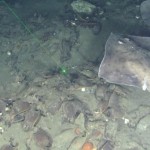Part three of four in a series about Greenpeace recent manned submersible expedition to two of the largest submarine canyons in the world, the Pribilof and Zhemchug Canyons in the Bering Sea off the west coast of Alaska.
 The following exclusive interview was conducted by Deep Sea News over email with John Hocevar, ocean specialist for the Greenpeace organization, and a sub-pilot for the 2007 Bering Witness Expedition.
The following exclusive interview was conducted by Deep Sea News over email with John Hocevar, ocean specialist for the Greenpeace organization, and a sub-pilot for the 2007 Bering Witness Expedition.
1. What is Greenpeace hoping to accomplish on this Bering Sea Expedition?
This expedition was about increasing our collective understanding of Bering Sea canyons. Policy makers have acknowledged that these are rare and diverse habitats, but declined to take action given that too little was known about the canyons to justify protecting them. How’s that for precautionary? We plan to present this new data as part of an appeal to end destructive fishing practices in these vital areas.
2. Has Greenpeace ever tried anything like this before?
We have collaborated with university and government scientists on deep sea exploration before on several occasions, most recently in the Mediterranean and the Azores. This is the first time we’ve used manned (peopled?) submersibles, though.
3. I see you have federal government collaborators on this cruise. Are they spying on you?
How does the saying go – keep your friends close, and your enemies closer? No, really, it was great having NOAA’s participation in this project. Bob Stone was enormously helpful to have on board, and the project was much stronger as a result of his involvement.
4. Who are your other partners in the expedition?
We set up a Scientific Advisory Committee to help tap into a broader range of expertise than we had on board.� People from Scripps, the Smithsonian, and a number of other institutions, universities, and NGOs have contributed their time and expertise into strengthening the study design, advising us on equipment, and helping with species identifications.
5. What kind of things did you find there in the Canyons?
 It’s too early to say for sure, but it looks like we may have found at least one new species of sponge, and we’ve certainly expanded the known range of a several other species. We collected dozens of invertebrates, so I’ll be very surprised if further analysis doesn’t reveal some additional new discoveries.
It’s too early to say for sure, but it looks like we may have found at least one new species of sponge, and we’ve certainly expanded the known range of a several other species. We collected dozens of invertebrates, so I’ll be very surprised if further analysis doesn’t reveal some additional new discoveries.
I was surprised to see how patchy these environments are. In several cases, sub pilots working just 100 meters apart saw very different things. One of the reasons for this is that much of the hard bottom in the canyons comes from drop stones deposited by ice bergs, which then become covered with the sponges, corals, anemones, bryozoans, and hydroids which provide habitat for a host of fishes and invertebrates. As a result, there may be no areas within the canyons which could be bottom trawled without destroying corals and sponges.
I was aware that the Bering Sea has been very heavily trawled, but I was also surprised to see so much evidence of trawling impacts. We saw trawl tracks all over the place, even at depths greater than 800 meters. In some areas, nearly every coral encountered over a very large area was either broken or knocked over.
6. Weather can be very unpredictable in the Bering Sea. Did you lose any scheduled dives?
Unpredictable weather in the Bering Sea? I have no idea what you are talking about! We did lose a couple days to particularly energetic seas and an over-abundance of moisture in the air (read: pea soup fog), but on the whole the weather was better than expected. We got in 25 sub dives and quite a few ROV dives, and spent over 50 hours on the bottom.
7. What’s next for Greenpeace in the Bering Sea?
The ship will be in Alaska for a while longer, to continue our series of discussions with native communities about marine cultural heritage zones. Heritage zones are essentially marine protected areas designed to give communities a voice in the management of fisheries that impact their way of life. These can include trawl exclusion zones near small-scale fishing communities as well as areas like the canyons which may be farther off shore but can be important foraging areas for species that are their traditional foods.
We’ll continue to push policy makers to take a more precautionary, ecosystem-based approach. In Alaska, the North Pacific Fishery Management Council gets a gold star for rhetoric, but the implementation can leave a bit to be desired.
8. Where do you go from here?
I’ll be focused on making sure that we make the most of the data we collected on this expedition – sharing material with interested scientists, writing up some of the results, and taking our case to policy makers to protect the canyons. At this point, I’m giving NMFS and the Council the benefit of the doubt, and hoping that they’ll welcome this new information and will quickly take action. Of course, if that turns out not to be the case, we won’t exactly let this go that easily. Sometimes these things take a little… prompting.





